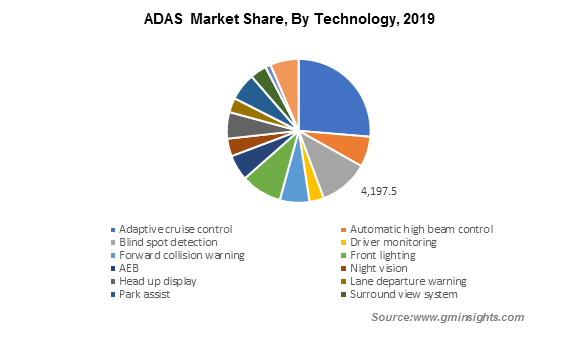Escalating demand from OEMs to augment advanced driver assistance systems market trends
Publisher : Fractovia | Latest Update: 2019-07-25 | Published Date : 2018-04-06Request Sample
The demand for driving security has rapidly surged since the last few years, fueling the growth of the advanced driver assistance systems (ADAS) market share. Amidst a scenario where the driving technology is witnessing a transition from human drivers to autonomous cars, ADAS is likely to gain significant impetus.
U.S. Advanced Driver Assistance System (ADAS) Market, By Vehicle, 2018 & 2025, (USD Million)

The fact that ADAS has started to play an increasingly important role in driver safety is apparent from certain reports claiming that the EU plans to mandate the inclusion of some ADAS technologies in new cars from 2020. The Euro NCAP, the crash testing body, is also planning to add advanced driver assistance systems to its standard vehicle tests. With such steps underway, leasing companies like Arval have already started to include specific ADAS in their fleets, potentially boosting ADAS market trends over the forecast period.
With an increasing amount of distractions such as cell phones and telematics interface, distracted driving has become a profound threat on roads. In consequence, automakers trying to bring more safety not only to drivers and passengers but to innocent bystanders as well, through the expansion of advanced driver assistance systems industry. Improved ADAS technologies such as adaptive cruise control, lane departure warning and automatic braking are becoming more and more popular owing to the fact that they are capable of kicking in before inattentive drivers can cause accidents.
Certain advancements in advanced driver assistance systems technologies are agile enough to detect drowsiness by sensing a head nod and will definitely make future automobiles safer. More common ADAS technologies like the GPS navigation have made paper maps almost obsolete. Their deployment is certain to eliminate accidents cause due to distracted driving, thereby fueling ADAS industry size. The EU has also mandated the installation of lane departure warning in all heavy trucks – further indicating that advanced driver assistance systems market trends are here to stay.
One of the major factors that will influence advanced driver assistance systems industry growth is the rate at which technological advancements are making their foray in this business space. In the recent years, semiconductor companies and other players in the automotive industry have made significant enhancements in the ADAS technology. For instance, the forward collision warning system is being increasingly made mandatory in heavy vehicles by regulatory bodies.
Studies conducted in relation to forward collision and automatic braking pointed out that the technology has resulted in 14% drop in property damage liability claims. Driven by the incredible benefits of this system and the strict regulatory framework, forward collision warning advanced driver assistance systems (ADAS) market size is expected to witness a commendable increase in the ensuing years.
Collision avoidance and collision mitigation systems in autobraking have also been gaining momentum in the ADAS industry as they have been tested to be highly effective under favorable conditions. Estimates claim that collision avoidance systems helped prevent a collision 60% of the times while collision mitigation prevented mishaps 33% of the times. Quite overtly, the figures point out that opting for the collision avoidance systems is more advantageous than opting for the latter. However, collision mitigation systems cost much lesser than the former, owing to which they are being made more widely available in vehicles.
Original equipment manufacturers have come to realize that in the near future, ADAS applications can become the chief feature that will make each automotive brand unique. On these grounds, not only OEMs, but even tech giants like Google are being more involved in the autonomous vehicle development. It is thus, rather apparent that the same technologies enabling ADAS will be found applicable in the success of autonomous vehicles. This has led OEMs to focus tremendously on advanced driver assistance systems market trends and contribute their bit toward the expansion of this business sphere. Indeed, advanced driver assistance systems (ADAS) industry is forecast to acquire a highly commendable share through OEMs in terms of volume over 2019-2025.
Considering the costs of advanced driver assistance systems and the fact that some of the largest producers of automobiles are located in North America, it is presumable that the region will emerge as a profitable avenue for ADAS market. Not to mention, consumer awareness has also led to relatively high adoption of ADAS technology in this region. Additionally, the continent is governed by a stringent regulatory framework, that has further augmented the regional advanced driver assistance systems industry size.
This business vertical however, has also depicted commendable expansion across the developing nations. Companies have been deploying collision mitigation system and lane departure warning system in their vehicles, thus making inroads for advanced driver assistance systems market to gain ground in India. Indeed, APAC has become an automotive hub owing to excessive automobile production in China, Japan, and South Korea. What’s more, these regions are now depicting enhanced living standards and consumer awareness for better road safety, that have contributed toward impelling APAC ADAS market outlook.
Though still a relatively young science, ADAS has the potential to grow immensely in the years ahead, considering the safety features it adds to vehicles. According to the WHO, 1.25 million people die due to road accidents every year. In fact, devoid of stringent traffic rules, road accidents are predicted to become the seventh leading cause of death by 2030. On these grounds, WHO has adopted the 2030 Agenda for sustainable development which aims at halving traffic crashes by 2020.
Technologies like ADAS are certainly expected to help meeting the targets for such ambitious agendas. Endorsed by a highly powerful regulatory frame of reference and the increasing tech advancements in the automotive space, advanced driver assistance systems market is expected to chart out a profitable growth path by 2024.